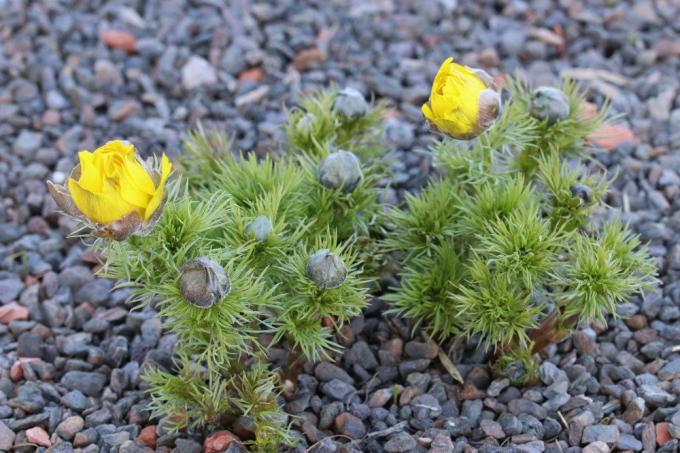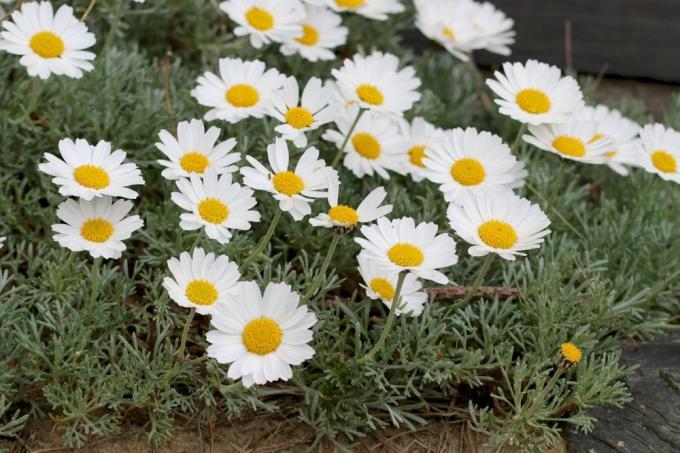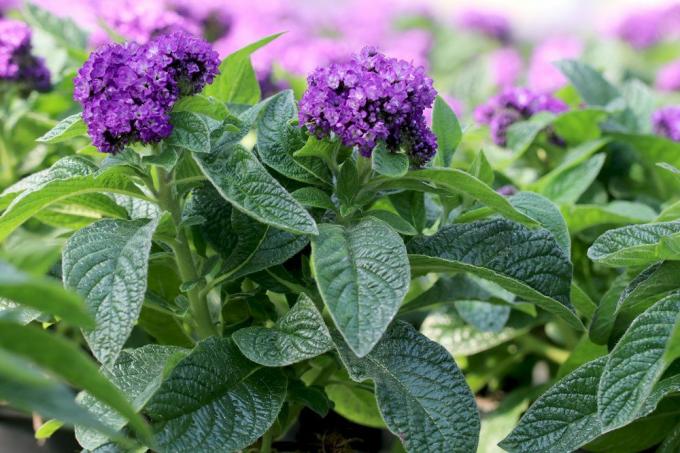
table of contents
- Bee-friendly balcony
- Balcony plants for bees from A - B
- Bee-friendly plants for the balcony from G - L
- Balcony plants for bees from L - M
- Plants from P - S
- Balcony plants for insects from T - W
Did you know you didn't garden need to provide a habitat for bees and other beneficial insects? Even a small balcony can be made bee-friendly by cultivating appropriate plants. The great thing about this is: The selection of plants for an insect-friendly balcony is extremely large and varied. You can find an overview of the most popular and at the same time bee-friendly plants for the balcony here!
Bee-friendly balcony
Ideally, balcony plants are not only decorative, but also bee-friendly. This means that there is valuable nectar or pollen in their flowers that the bees can feed on. The plants should bloom at different times if possible so that the useful helpers can always use the food source. A wide variety of plants are ideal for this, because there are both early and late bloomers. For the eager nectar collectors, the most varied planting possible is an advantage. A bee-friendly balcony is therefore characterized by the following features:
- early and late flowering plants
- different types of plants
- Balcony plants with a high nectar value
Balcony plants for bees from A - B
Adonis
Adonis are characterized by their early flowering, which already takes place in February. Bees and other nectar collectors are particularly happy about it, because they are supplied with nutritious nectar at the beginning of the year. The Adonis can stand on a sunny as well as on a partially shaded balcony. It should be noted that the location preferences of the more than 20 species can vary. While the Adonis vernalis, for example, has a sunny and warm place, the Adonis amurensis prefers it to be cool and partially shaded.
- Latin name: Adonis amurensis
- Flower color: yellow
- Flowering period: February to April
- Location: sunny to partially shaded

Note: Adonis are highly poisonous!
Common heather
Common heather can often be found in fields and meadows in the wild. There it is an important source of food for numerous insects, because its nectar value is very high. The common heather is not only insect-friendly, but also very pretty to look at. Its grape-like inflorescence blooms - depending on the species - in a wide variety of colors. They appear particularly decorative when heather of different colors are cultivated together. Larger balcony boxes are suitable for this, which is best sunny locations to be placed.
- Latin name: Calluna vulgaris
- Flower color: purple, yellow, orange, pink, red, white
- Flowering period: July to November
- Location: sunny, partially shaded

Note: The common heather is used for the production of heather honey.
Blackberries and raspberries
Those who like to eat berries are well advised to use blackberries and raspberries. The two shrubs can easily be cultivated on the balcony, provided that it is in the sun. The plants start to bloom as early as May and attract bees thanks to their high nectar and pollen content. Early bloomers like these are a welcome source of food for insects, especially at the beginning of spring, as few plants are still blooming at this time.
- Latin name: Rubus sect. Rubus and Rubus idaeus
- Synonyms: wild berry, blackberry, dewberry, thornberry
- Flowering period: May to August
- Location: sunny

Bee-friendly plants for the balcony from G - L
Common stone quendel
The common stone quendula is an upright and bushy growing one shrubwhich forms a multitude of small flowers. These are usually only about one centimeter in size, but contain valuable nectar. This is a welcome source of food for numerous insects, such as bees and hover flies. The common stone whale is therefore considered to be insect-friendly and supplies the beneficial insects with nectar until October.
- Latin name: Calamintha nepeta
- Synonyms: small-flowered mountain mint, glandular mountain mint
- Height: 30 - 50 cm
- Flower color: white, purple
- Flowering period: July to October
- Location: sunny

Catnip
It is primarily interesting for cats, because they like to sniff the plant. The lemon-like smell is not only interesting for fur noses, but also for insects. Because catnip is ideal for a bee-friendly balcony. Bees in particular are magically attracted by the scent and find nourishing nectar in the flowers. The catnip is considered to be quite undemanding and also copes well with drought. Only in winter does it need a little more attention, because in the cold season it should be equipped with frost protection.
- Latin name: Nepeta
- Flower color: blue-violet or white
- Flowering period: May to September
- Location: sunny

Balcony plants for bees from L - M
lavender
Lavender is one of the most popular balcony plants and can be used in many ways. It can be cultivated as a decorative eye-catcher on the balcony, but can also be used in the kitchen and as a remedy. On top of that, it is bee-friendly and provides the insects with food on the balcony. While bees are literally drawn to the scent of lavender, mosquitoes and other pests stay away from it. Thus, the lavender is a true all-rounder, which is also in the Pest Control has proven useful.
- Latin name: Lavandula angustifolia
- Synonyms: Real Lavender, Little Speik
- Height: 60 - 100 cm
- Flower color: purple, pink or white
- Flowering period: June to August
- Location: sunny and warm

Daisies
There are around 42 species of the popular daisies, all of which are native to Europe. The flower is not only pretty to look at, but also bee-friendly. Because their large, white flowers are easily accessible and provide food for bees from May to October. The plant is happy to have a sunny spot on the balcony, but it can also cope with partial shade.
- Latin name: Leucanthemum
- Synonyms: Daisy, Large Measure Love, Wiesenwucherblume
- Height: 30 - 70 cm
- Flower color: white, yellow
- Flowering period: May to October
- Location: sunny to partially shaded

Note: The marguerite is not only edible, but is also considered a medicinal herb.
Plants from P - S
Purslane florets
Purslane florets are particularly decorative balcony plants because their flowers shine intensely in a wide variety of colors. It grows overhanging, which is why it is very suitable for hanging baskets or window boxes. As beautiful as these balcony plants are, they are also easy to care for. It is important, however, that the plants are placed in a sunny location. This is where their flowers develop best, attracting numerous insects and providing them with food.
- Latin name: Portulaca grandiflora
- Flower color: pink, white, red, yellow, orange, purple, multicolored
- Flowering period: June to August
- Location: sunny

Marigold
Marigolds bring color to the balcony, because the plants glow in different colors. This not only pleases people, but also bees and insects. Because marigolds are bee-friendly and provide the animals with valuable nectar until autumn. So that the marigold blooms as intensively as possible, it should be placed in a sunny location.
- Latin name: Calendula officinalis
- Height: 20 - 60 cm
- Flower color: yellow, orange, carmine red
- Flowering period: May to October
- Location: sunny to shady

Note: The flowering of the marigold is particularly intense in the first six weeks. After that, it forms more flowers, but these are usually a little smaller.
Jewelry basket
The decorative basket also inspires people and insects alike: the ornamental plant forms one Variety of brightly colored flowersthat are not only decorative but also rich in nectar. It blooms into September and provides the beneficial insects with food throughout the summer. They are also for us humans Edible flowerswhich taste slightly sweet and make a wonderful decoration on salads and desserts.
- Latin name: Cosmos bipinnatus
- Synonyms: Cosmea
- Flower color: red, pink, white
- Flowering period: July to October
- Location: sunny to partially shaded

Balcony plants for insects from T - W
thyme
Thyme is a popular kitchen spice that can easily be grown on the bee-friendly balcony. There many insects enjoy the nectar it contains, because the nectar value of thyme is extremely high. That is why thyme is particularly important for wild bees and butterflies. If you want to make your balcony insect-friendly, thyme is well advised in every respect.
- Latin name: Thymus vulgaris
- Synonyms: evergreen, Roman quendel, real thyme
- Flower color: white, pink
- Flowering period: May to September
- Location: full sun and warm

Note: Thyme is perennial and can be overwintered. For this, however, it should be protected from frost in any case.
Vanilla flower
The vanilla flower is not only a decorative plant for the balcony, it is also insect-friendly. Both bees and butterflies are attracted to the scent of the flower. This is also noticeable for people, because the vanilla flower smells - as the name suggests - pleasantly of vanilla. Despite all its peculiarities, the plant is considered to be very easy to care for, only too long dry periods should be avoided.
- Latin name: Heliotropium arborescens
- Synonyms: Solstice shrubs
- Growth height: up to 60 cm
- Flower color: dark purple, blue
- Flowering period: May to September
- Location: sunny to partially shaded

Note: All plant parts of the vanilla flower are highly poisonous!
Wild Wine
Not only flowers and herbs are bee-friendly plants for the balcony, because climbing plants are also rich in nectar and pollen. One of these plants is wild wine, which is great for planting on walls and Trellises suitable. The climbing plant is considered to be very easy to care for and has no specific requirements for the location. Because wild wine can be cultivated in the sun as well as in partial shade or shade.
- Latin name: Parthenocissus quinquefolia
- Flowering period: July to August
- Flower color: white
- Location: sunny, partially shaded or shady

